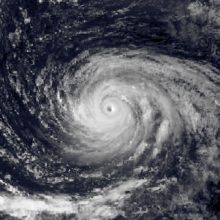 Typhoon Vera at peak intensity on August 22 | |
| Meteorological history | |
|---|---|
| Formed | August 13, 1986 |
| Dissipated | August 29, 1986 |
| Very strong typhoon | |
| 10-minute sustained (JMA) | |
| Highest winds | 165 km/h (105 mph) |
| Lowest pressure | 925 hPa (mbar); 27.32 inHg |
| Category 3-equivalent typhoon | |
| 1-minute sustained (SSHWS/JTWC) | |
| Highest winds | 205 km/h (125 mph) |
| Overall effects | |
| Fatalities | 60 total |
| Damage | $22 million |
| Areas affected | Okinawa, China, South Korea, Russia |
Part of the 1986 Pacific typhoon season | |
Typhoon Vera, known as Typhoon Loleng in the Philippines,[1] affected Okinawa, China, and South Korea during August 1986. A tropical depression formed on August 13 and attained tropical storm intensity later that day. Initially, Vera meandered in the monsoon trough. On August 17, however, the system abruptly re-formed to east-northeast, and subsequently began to move east and then north. Vera became a typhoon on August 20, and peaked in intensity two days later. Typhoon Vera then turned west-northwest and slowly weakened as it approached Okinawa. After passing near the island, Vera turned north as it tracked east of China. The typhoon made landfall on South Korea on August 28 as a tropical storm, and the next day, transitioned into an extratropical cyclone.
The typhoon was responsible for minor damage to Okinawa, where 20,000 houses lost power and one fatality was reported. Although the core remained offshore China, over 500 homes were destroyed, 7 people died, and 28 people were hurt in Shanghai. Nationwide, 1,400 power lines were cut and eight fatalities were reported. Across South Korea, a total of 1,852 structures were damaged and 384 others were destroyed, which left 6,623 people without shelter. The storm also wrecked 929 boats and damaged 37 ports. A total of 9,145 hectares (22,600 acres) of farmland were flooded. Damage totaled $22 million (1986 USD). Nationwide, 26 people were killed and 81 others were injured. In addition to the aforementioned casualties, 25 individuals were feared dead after the ship New Genshine went missing.
- ^ Padua, Michael V. (November 6, 2008). PAGASA Tropical Cyclone Names 1963–1988 (Report). Typhoon 2000. Retrieved May 16, 2017.
© MMXXIII Rich X Search. We shall prevail. All rights reserved. Rich X Search
